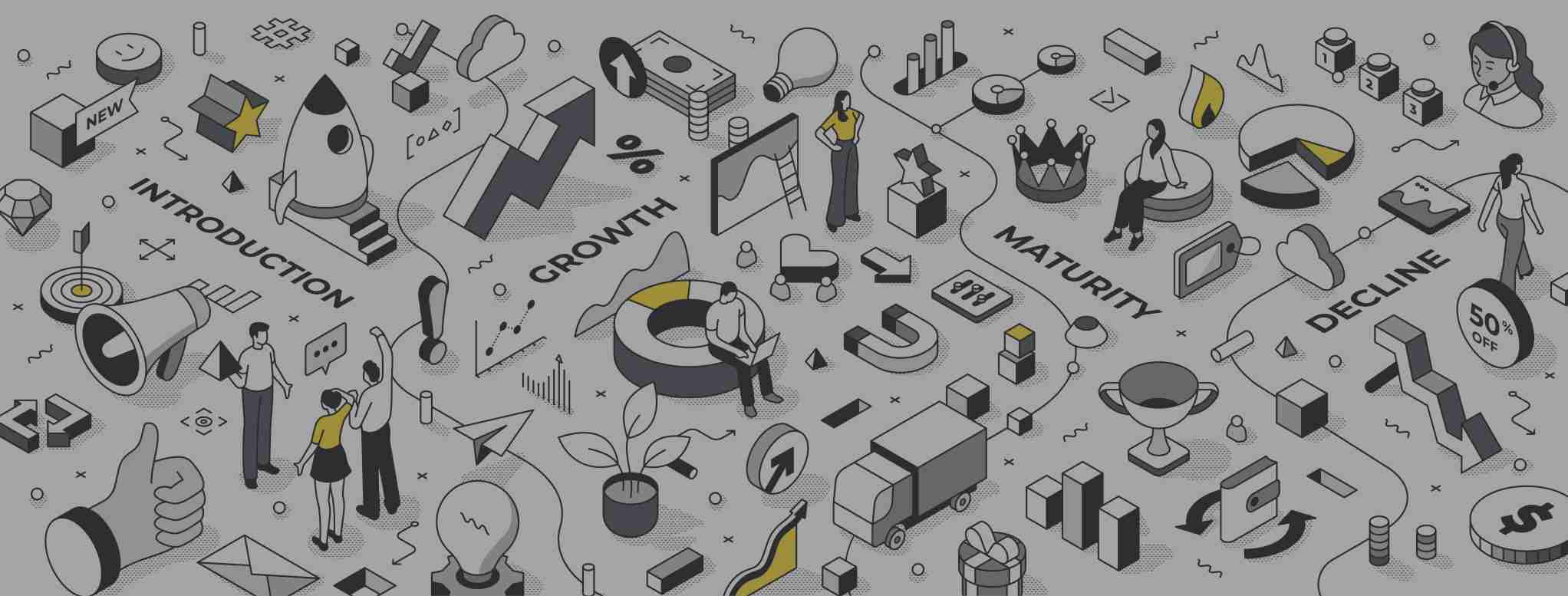The B2B SaaS and fintech landscape has never been more cutthroat. The acceleration of technological advancements, unprecedented global market expansion, vertical SaaS growth, skyrocketing consumer expectations and diminishing funding and investment means it’s a jungle out there. Businesses in this space need a greater competitive edge than ever, and this means a deeper understanding of your customers.
As GTM specialists, we see an astonishing number of companies with a surface-level knowledge of their customers, and we want to rectify that - even if you don’t hire us to help. So, this article dives into exactly why it’s such a critical factor for success and how to go about building the knowledge you need.
Why understanding your target market matters more than ever
Knowing your customer inside out directly impacts the bottom line and market positioning. Here’s how:
- Enhanced product development: Companies with top-tier Net Retention Rates like Twilio and Crowdstrike are nailing it because they know what their customers want and deliver without missing a beat. They're not guessing; they're building products that stick because they've got the inside scoop on their users' needs.
- Improved customer experience: 90% of B2B buyers are kicking off their purchase journey online. If you're not crafting an online experience that's as smooth as butter, you're out. Understanding your customer means you can create a digital journey that's more intuitive.
- Increased customer retention and loyalty: Customer retention is critical, especially when considering that the median Customer Acquisition Cost (CAC) for SaaS companies has surged by a whopping 180%.
- More effective marketing and sales strategies: Understanding customer needs allows for more targeted marketing and sales strategies. The current average B2B SaaS sales cycle is 32% longer than it used to be. And with 50% of B2B marketing leaders in the UK juggling cuts to budgets and headcount, resources across the board have to be more targeted and efficient to hit loftier targets.
- Enhanced customer satisfaction and support: Understanding customer preferences can lead to better support and success initiatives. For fintech companies, responsive support is a non-negotiable asset. According to one Gartner survey, 86% of B2B customers expect companies to be well-informed about their personal information during a service interaction
Before you can get to this endpoint (or the beginning of growth as it were) you must build on the foundation of:
- Buyer personas
- Ideal customer profiles (ICP)
- Understanding your total addressable market (TAM)
- Refining messaging to resonate with the target market
- Strategic use of customer data and segmentation within your CRM system
The "Assess" phase of the ARISE™ framework provides a structured approach to achieving this.
The power of buyer personas
Buyer personas are semi-fictional representations of your ideal customers based on real data and some select educated assumptions. They are the archetypes around which your entire marketing and sales strategies should revolve. Creating detailed buyer personas involves a deep dive into the demographics, behaviour patterns, motivations and goals of your target audience.
For B2B SaaS and fintech companies, buyer personas help tailor the development and marketing of products to meet the specific needs of different user groups. They enable you to craft messages that resonate with the challenges and pain points of your customers, ensuring that your marketing efforts are not just seen but felt.
(Need help creating these? Check out our comprehensive eBook here or book in a buyer persona workshop.)
Crafting the ideal customer profile
While buyer personas provide a snapshot of your customers, the Ideal Customer Profile (ICP) defines the perfect organisation that would benefit from your service. It's a blueprint that guides your sales teams to focus their efforts on the accounts that are most likely to convert and provide the highest lifetime value.
An ICP includes firmographic data such as company size, industry, revenue, and geographic location. It's a strategic tool that aligns marketing and sales efforts, ensuring that resources are invested in the most promising prospects.
At BIAS, as a part of the “Assess” phase of our process, we gather evidence and take stock of where the business stands today, which includes defining your buyer personas and identifying your ICP. This involves a deep dive into your current and potential customers to understand their needs, challenges and behaviours. For one recent customer, this involved undertaking over 100 man-hours of research.
Defining your total addressable market
Determining your TAM and potential revenue is a critical component of the "Assess" phase. This involves estimating the overall revenue opportunity available if the company captured 100% of its specific market segment. Understanding the TAM helps in setting realistic sales and growth targets and focusing efforts on the most lucrative market segments.
Building and testing your messaging
Understanding how your positioning is reflected in the market and whether it resonates with your target audience is essential. The "Assess" phase involves revisiting your positioning and optimising it for better results. This may include A/B testing different messaging strategies across various channels to determine what best appeals to each segment.
Feedback and performance metrics from these tests can then inform adjustments to ensure that the messaging effectively communicates the value proposition to the intended audience.
Leveraging customer data and segmentation
The lifeblood of any customer-centric strategy is data. Customer Relationship Management (CRM) systems are treasure troves of information that, when used effectively, can transform your business approach. Segmentation within a CRM allows you to divide your customer base into distinct groups based on shared characteristics, such as demographics, behaviours and needs.
Segmentation enables personalised marketing campaigns, targeted sales pitches and improved customer service. By utilising the insights gained during the "Assess" phase, companies can create segments that are aligned with their ICP and personas, ensuring that marketing efforts are focused on the most promising prospects.
Moreover, it increases the likelihood that the right message reaches the right customer at the right time, increasing the relevance of your communications and enhancing the customer experience (and ultimately, retention).
Utilise your CRM
According to CSO Insights, less than 37% of sales reps actually use their company’s CRM system and under 40% of CRM customers have end-user adoption rates above 90%. This is a problem. If your revenue teams aren’t using your CRM to its full potential, they’re working off disparate, potentially out-of-date customer information and cannot fully personalise, nurture leads or segment appropriately. This not only impacts customer experience but the length of sales cycles - which affects revenue.
The "Assess" phase nips this issue in the bud by ensuring that personas, ICP and workflows are accurately reflected and set up in your CRM. This setup facilitates a revenue focus and personalisation by enabling automated, targeted communications and tracking customer interactions throughout the sales funnel.
Impact on messaging and personalisation
Understanding your customer through personas, ICPs and segmentation allows for highly personalised messaging. In the SaaS and fintech sectors, where products can be complex, personalisation helps simplify the message, making it more accessible and relevant to each customer. Personalisation extends beyond marketing into sales, where sales reps can also use these insights to address specific customer needs and objections.
The insights gathered during the "Assess" phase enable companies to tailor their communications, offers and product recommendations to meet the specific needs and preferences of different segments. This level of personalisation can significantly improve conversion rates and customer loyalty.
Reducing customer acquisition costs
A detailed understanding of your market and audience, combined with effective use of your CRM to target them accordingly, can significantly reduce your CAC over time. By focusing marketing and sales efforts on high-value segments and personalising the customer journey, B2B SaaS and fintech companies can achieve higher conversion rates with lower expenditure on broad-based marketing campaigns.
Segmentation and personalisation also contribute to a lower churn rate, as customers are more likely to stick with a service that understands and caters to their unique needs. The added bonus here: higher customer lifetime value (CLV).
Conclusion
For B2B SaaS and fintech companies, the customer is king. Building detailed buyer personas, defining your ICP and leveraging customer data for segmentation are not just marketing activities. They are strategic imperatives that drive your business forward.
By focusing on understanding your customer, you can deliver personalised experiences that resonate, build lasting relationships, and ultimately, drive growth with a more efficient allocation of your resources.
If you’re looking for support to deliver on this, the "Assess" phase of the ARISE™ framework offers a structured approach for SaaS and fintech companies to deeply understand their target audience and refine their go-to-market strategies for long-term success. Get in touch with the BIAS team if you have any questions or would like to chat things through.




